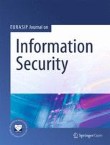An Extended Image Hashing Concept: Content-Based Fingerprinting Using FJLT
Dimension reduction techniques, such as singular value decomposition (SVD) and nonnegative matrix factorization (NMF), have been successfully applied in image hashing by retaining the essential features of the...
